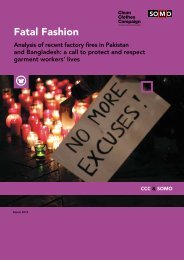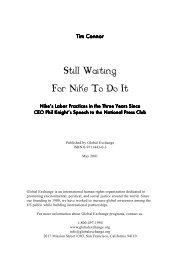You also want an ePaper? Increase the reach of your titles
YUMPU automatically turns print PDFs into web optimized ePapers that Google loves.
For example one supplier felt that the demand<br />
requiring him to return passports to migrant workers<br />
would result in workers choosing to leave or break the<br />
terms of their contracts. 50<br />
Brands and retailers<br />
Protecting their reputation<br />
We interviewed a number of brands and retailers,<br />
many of whom we know have had or do have migrant<br />
workers in their supply chains. The responses were<br />
extremely varied, and the quality of response was<br />
closely related to the kind of experience they have had<br />
in dealing with high profile cases of migrant worker<br />
exploitation in their supply chains.<br />
Those companies who outlined the most concrete<br />
steps to address migrant worker issues and had<br />
developed strategic guidelines and procedures to<br />
detect and remediate them were NEXT and Arcadia<br />
(buyers from CMT Mauritius in 2007), Nike (buyers<br />
from Hytex, Malaysia in 2008), and Jones (one of the<br />
buyers identified in NLC research in Jordan 2006).<br />
All of these cases made headline news in major retail<br />
countries, news that linked their brand name with a<br />
word like “slavery.” As the ETI told us<br />
“No company wants to have their brand name linked<br />
with such an emotive word.” 51<br />
Two further companies interviewed, ASDA and HEMA,<br />
had also experienced cases involving migrant workers<br />
(both in Mauritius), yet had still not developed any<br />
kind of strategy for remediation of violations involving<br />
migrant workers. ASDA was also implicated in the<br />
CMT case, but was never linked so publicly in the<br />
media. They seem to have piggybacked on some<br />
of the work done by NEXT and Arcadia in resolving<br />
that case, but this had not led to development of any<br />
company policies. HEMA was also involved in a case<br />
in Mauritius in 2002, but as they themselves acknowledge,<br />
“we did a lot of work at the time but no longer<br />
have the details,” they could not confirm if they still<br />
buy from the factory involved. Again HEMA did not<br />
consider their other sourcing countries to be high risk<br />
thus it appears migrant workers are not a priority issue<br />
for them. Primark clearly had some knowledge of the<br />
problems of remediating migrant worker violations, but<br />
were interviewed only weeks after an expose highlighted<br />
migrant worker abuse in a UK supplier and had<br />
yet to convert this learning into a strategic response.<br />
Adidas and H&M had not been publicly linked to<br />
migrant workers’ rights violations but still had some<br />
awareness of the need to address the specific types<br />
of exploitation that they are vulnerable to. Adidas was<br />
contacted by campaigners when the Hytex case went<br />
public and was clearly concerned that they were at<br />
risk of future exposure. 52 H&M have not had any public<br />
cases involving migrant workers, but are also aware<br />
that there are risks in their supply chain and seem to<br />
be following the debate and have some view of what<br />
the main issues may be for them. They are working on<br />
internal migrant issues in China.<br />
Carrefour gave the weakest response of the<br />
companies contacted by the CCC. They have never<br />
been publicly linked to the use of migrant workers in<br />
their supply chain and clearly consider that there is a<br />
low risk of finding migrant workers in the future.<br />
From the above we can conclude that brand reputation<br />
is the primary motivation for brands and retailers,<br />
and the extent to which they view this reputation to be<br />
“at risk” determines their actions. Work to identify and<br />
address violations of migrant workers rights is only<br />
a priority for those companies who see it as a “high<br />
risk” area. Public exposure of migrant worker abuse<br />
could, therefore, be useful in getting this issue on the<br />
CSR agenda of brands and retailers. Follow up not<br />
only with the retailers directly implicated in a case, but<br />
with other brands and retailers that may have migrant<br />
workers in their supply chain could ensure such public<br />
exposure has a wider impact on the industry.<br />
The examples of ASDA and HEMA show that individual<br />
cases do not always lead to long term or strategic<br />
supply chain actions. Nor do they necessarily force<br />
migrant worker rights onto the wider industry CSR<br />
agenda. More work needs to be done to raise the<br />
visibility of migrant workers and ensure that demands<br />
voiced by migrant workers are addressed.<br />
Codes of conduct and policies<br />
Most companies surveyed believe that the issues<br />
faced by migrant workers are already covered by their<br />
codes of conduct and most have not included specific<br />
reference to migrant workers in their codes. There are<br />
some exceptions:<br />
H&M does include specific reference to migrant<br />
workers in their code. Their code states that:<br />
“If foreign workers are employed on contract basis,<br />
they should never be required to remain employed<br />
for any period of time against their own will. All commissions<br />
and other fees to the recruitment agency in<br />
connection with their employment should be covered<br />
by the employer” (H&M code, 4.1.2).<br />
30 False Promises Migrant Workers in the Global Garment Industry





